Dissertation on Culturally Targeted Interventions for South Asian T2D
VerifiedAdded on 2023/06/11
|78
|24322
|108
Thesis and Dissertation
AI Summary
This dissertation systematically reviews culturally appropriate interventions for preventing or managing Type 2 Diabetes (T2D) in the South Asian population, who have a higher risk of developing the condition due to genetic and lifestyle factors like poor diet, sedentary habits, and high abdominal fat. The research investigates various intervention types, including structured exercise, educational programs, culturally competent strategies, multi-component approaches, and diet modifications. It highlights the increased susceptibility of South Asians to insulin resistance and T2D at younger ages, emphasizing the need for tailored interventions to address specific cultural needs and improve diabetes management within this population. The study uses a systematic methodology to analyze existing literature and identify effective strategies for delaying the onset or improving the management of T2D among South Asians.
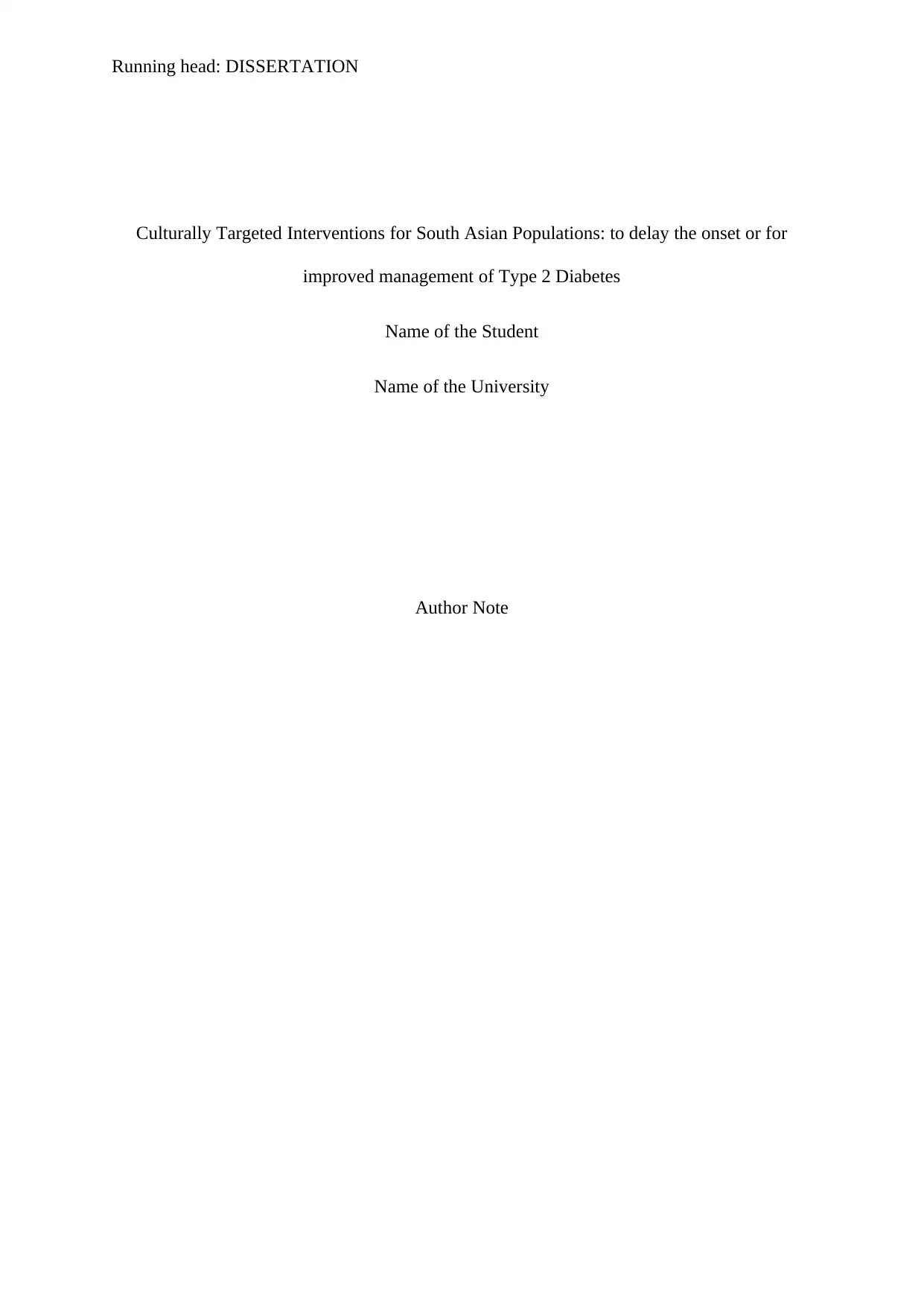
Running head: DISSERTATION
Culturally Targeted Interventions for South Asian Populations: to delay the onset or for
improved management of Type 2 Diabetes
Name of the Student
Name of the University
Author Note
Culturally Targeted Interventions for South Asian Populations: to delay the onset or for
improved management of Type 2 Diabetes
Name of the Student
Name of the University
Author Note
Paraphrase This Document
Need a fresh take? Get an instant paraphrase of this document with our AI Paraphraser

1DISSERTATION
Abstract
Diabetes mellitus type 2 is a chronic metabolic disorder, the common symptoms of which are
increased blood glucose due to subsequent lack of insulin and insulin resistance among the
affected individuals. T2D commonly occurs due to obesity and a sedentary lifestyle. This
increases the risk of some individuals to suffer from the condition. A combination of genetic
and lifestyle factors are found responsible for the metabolic disorder and some of these
factors are under control of the people. Presence of inappropriate BMI, poor dietary patterns
and absence of physical exercise greatly contribute to the accumulation of body fat among
people of South Asian descent. A high waist to hip ratio is another marker for the presence
of diabetes. South Asian population have been associated with increased consumption of
sweetened drinks, saturated fat, and refined grains such as, white rice that play an important
role in increasing their risks. Insufficient production of the hormone insulin from the
pancreatic cells also contribute to insulin resistance and marks the inappropriate release of
glucose into the bloodstream. Other mechanisms associated with T2D development are lipid
breakdown, increased glucagon and more water and salt retention. This dissertation is an
attempt to conduct a systematic review for investigating the different culturally appropriate
interventions that have been found effective for preventing or managing T2D in the South
Asian population.
Keywords- diabetes, T2D, dietary, South Asian, dietary, exercise, interventions
Abstract
Diabetes mellitus type 2 is a chronic metabolic disorder, the common symptoms of which are
increased blood glucose due to subsequent lack of insulin and insulin resistance among the
affected individuals. T2D commonly occurs due to obesity and a sedentary lifestyle. This
increases the risk of some individuals to suffer from the condition. A combination of genetic
and lifestyle factors are found responsible for the metabolic disorder and some of these
factors are under control of the people. Presence of inappropriate BMI, poor dietary patterns
and absence of physical exercise greatly contribute to the accumulation of body fat among
people of South Asian descent. A high waist to hip ratio is another marker for the presence
of diabetes. South Asian population have been associated with increased consumption of
sweetened drinks, saturated fat, and refined grains such as, white rice that play an important
role in increasing their risks. Insufficient production of the hormone insulin from the
pancreatic cells also contribute to insulin resistance and marks the inappropriate release of
glucose into the bloodstream. Other mechanisms associated with T2D development are lipid
breakdown, increased glucagon and more water and salt retention. This dissertation is an
attempt to conduct a systematic review for investigating the different culturally appropriate
interventions that have been found effective for preventing or managing T2D in the South
Asian population.
Keywords- diabetes, T2D, dietary, South Asian, dietary, exercise, interventions

2DISSERTATION
Acknowledgement
I wish to express my deepest gratitude to the dissertation committee chair person
Professor-------, who convincingly and continually conveyed the spirit of research in regards
to this work. Without his continued guidance and help, this research would not have been
successfully accomplished.
I would to acknowledge the help extended by the committee members, Professor ---- and
Professor ----, who helped me engage in an accurate process for searching literature, relevant
to the research topic.
In addition, I would also thank Professor ---, who was imperative in introducing me to the
topic Diabetes, and whose enthusiasm for the same made me consider it an appropriate
subject for the research project. I would also like to thank the University of --- for providing
me the permission to access databases and library resources for the research purpose. I hereby
extend my thanks and gratitude to my family members and friends, without whom this work
would not have been possible.
Acknowledgement
I wish to express my deepest gratitude to the dissertation committee chair person
Professor-------, who convincingly and continually conveyed the spirit of research in regards
to this work. Without his continued guidance and help, this research would not have been
successfully accomplished.
I would to acknowledge the help extended by the committee members, Professor ---- and
Professor ----, who helped me engage in an accurate process for searching literature, relevant
to the research topic.
In addition, I would also thank Professor ---, who was imperative in introducing me to the
topic Diabetes, and whose enthusiasm for the same made me consider it an appropriate
subject for the research project. I would also like to thank the University of --- for providing
me the permission to access databases and library resources for the research purpose. I hereby
extend my thanks and gratitude to my family members and friends, without whom this work
would not have been possible.
⊘ This is a preview!⊘
Do you want full access?
Subscribe today to unlock all pages.

Trusted by 1+ million students worldwide
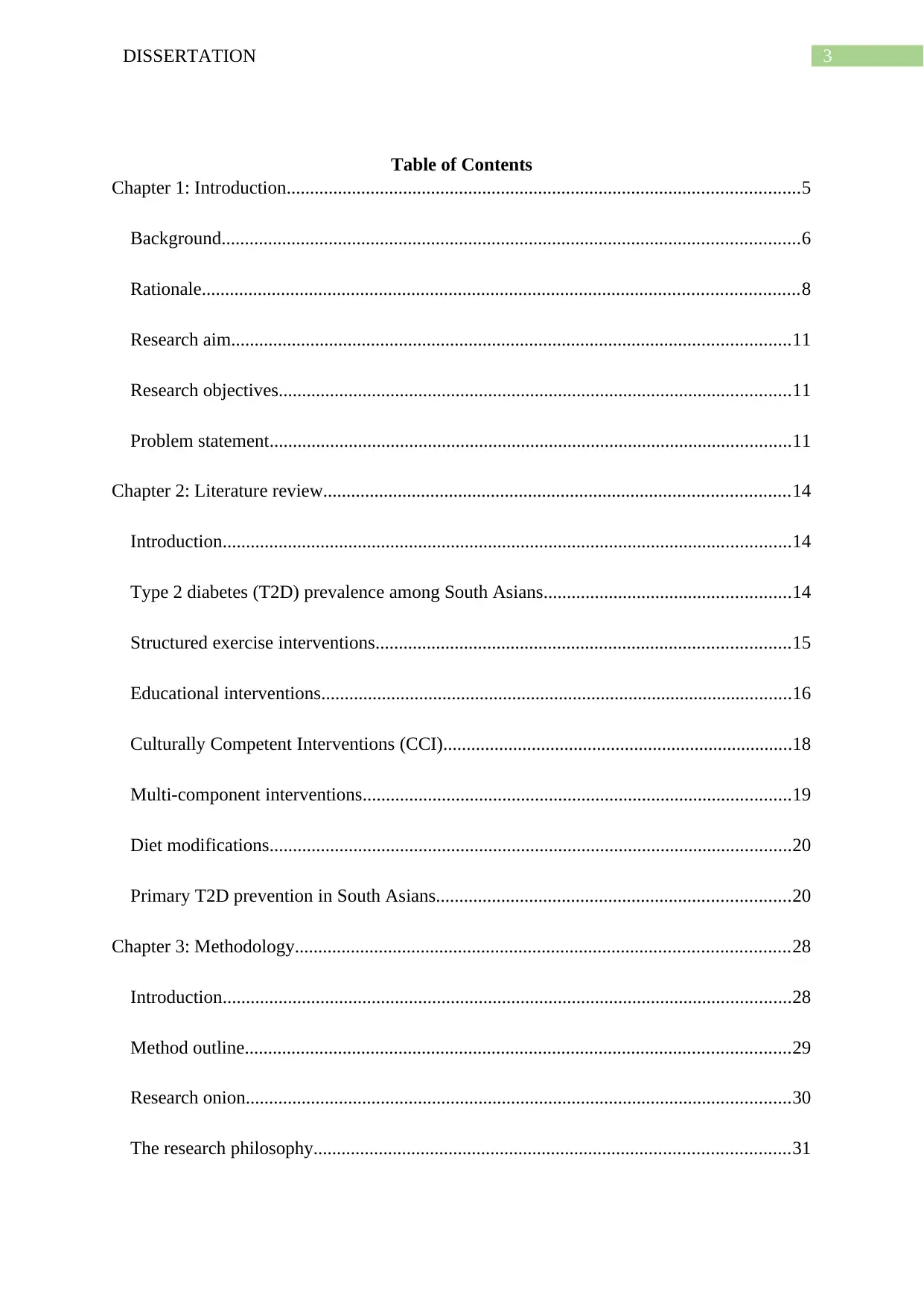
3DISSERTATION
Table of Contents
Chapter 1: Introduction..............................................................................................................5
Background............................................................................................................................6
Rationale................................................................................................................................8
Research aim........................................................................................................................11
Research objectives..............................................................................................................11
Problem statement................................................................................................................11
Chapter 2: Literature review....................................................................................................14
Introduction..........................................................................................................................14
Type 2 diabetes (T2D) prevalence among South Asians.....................................................14
Structured exercise interventions.........................................................................................15
Educational interventions.....................................................................................................16
Culturally Competent Interventions (CCI)...........................................................................18
Multi-component interventions............................................................................................19
Diet modifications................................................................................................................20
Primary T2D prevention in South Asians............................................................................20
Chapter 3: Methodology..........................................................................................................28
Introduction..........................................................................................................................28
Method outline.....................................................................................................................29
Research onion.....................................................................................................................30
The research philosophy......................................................................................................31
Table of Contents
Chapter 1: Introduction..............................................................................................................5
Background............................................................................................................................6
Rationale................................................................................................................................8
Research aim........................................................................................................................11
Research objectives..............................................................................................................11
Problem statement................................................................................................................11
Chapter 2: Literature review....................................................................................................14
Introduction..........................................................................................................................14
Type 2 diabetes (T2D) prevalence among South Asians.....................................................14
Structured exercise interventions.........................................................................................15
Educational interventions.....................................................................................................16
Culturally Competent Interventions (CCI)...........................................................................18
Multi-component interventions............................................................................................19
Diet modifications................................................................................................................20
Primary T2D prevention in South Asians............................................................................20
Chapter 3: Methodology..........................................................................................................28
Introduction..........................................................................................................................28
Method outline.....................................................................................................................29
Research onion.....................................................................................................................30
The research philosophy......................................................................................................31
Paraphrase This Document
Need a fresh take? Get an instant paraphrase of this document with our AI Paraphraser
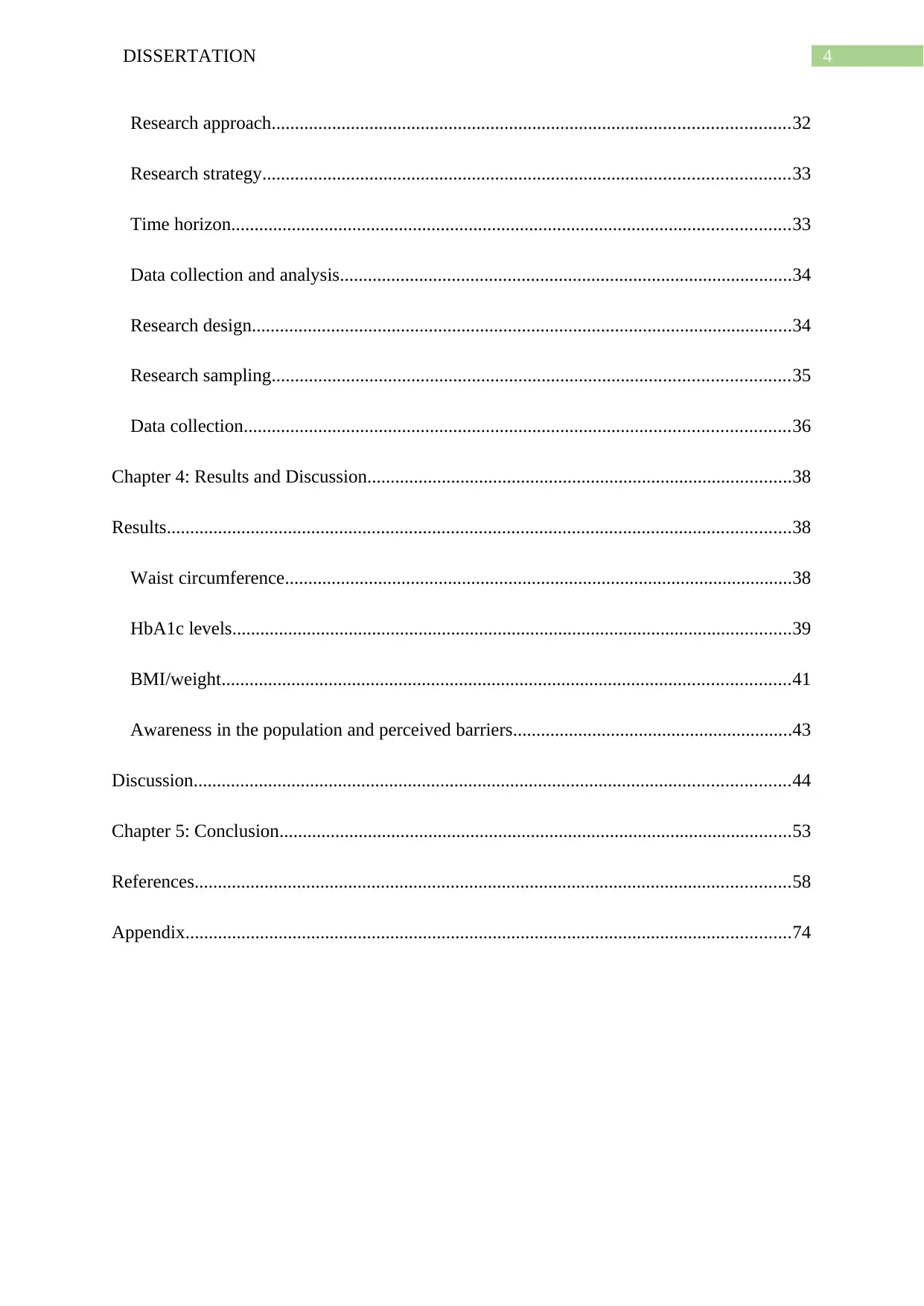
4DISSERTATION
Research approach...............................................................................................................32
Research strategy.................................................................................................................33
Time horizon........................................................................................................................33
Data collection and analysis.................................................................................................34
Research design....................................................................................................................34
Research sampling...............................................................................................................35
Data collection.....................................................................................................................36
Chapter 4: Results and Discussion...........................................................................................38
Results......................................................................................................................................38
Waist circumference.............................................................................................................38
HbA1c levels........................................................................................................................39
BMI/weight..........................................................................................................................41
Awareness in the population and perceived barriers............................................................43
Discussion................................................................................................................................44
Chapter 5: Conclusion..............................................................................................................53
References................................................................................................................................58
Appendix..................................................................................................................................74
Research approach...............................................................................................................32
Research strategy.................................................................................................................33
Time horizon........................................................................................................................33
Data collection and analysis.................................................................................................34
Research design....................................................................................................................34
Research sampling...............................................................................................................35
Data collection.....................................................................................................................36
Chapter 4: Results and Discussion...........................................................................................38
Results......................................................................................................................................38
Waist circumference.............................................................................................................38
HbA1c levels........................................................................................................................39
BMI/weight..........................................................................................................................41
Awareness in the population and perceived barriers............................................................43
Discussion................................................................................................................................44
Chapter 5: Conclusion..............................................................................................................53
References................................................................................................................................58
Appendix..................................................................................................................................74
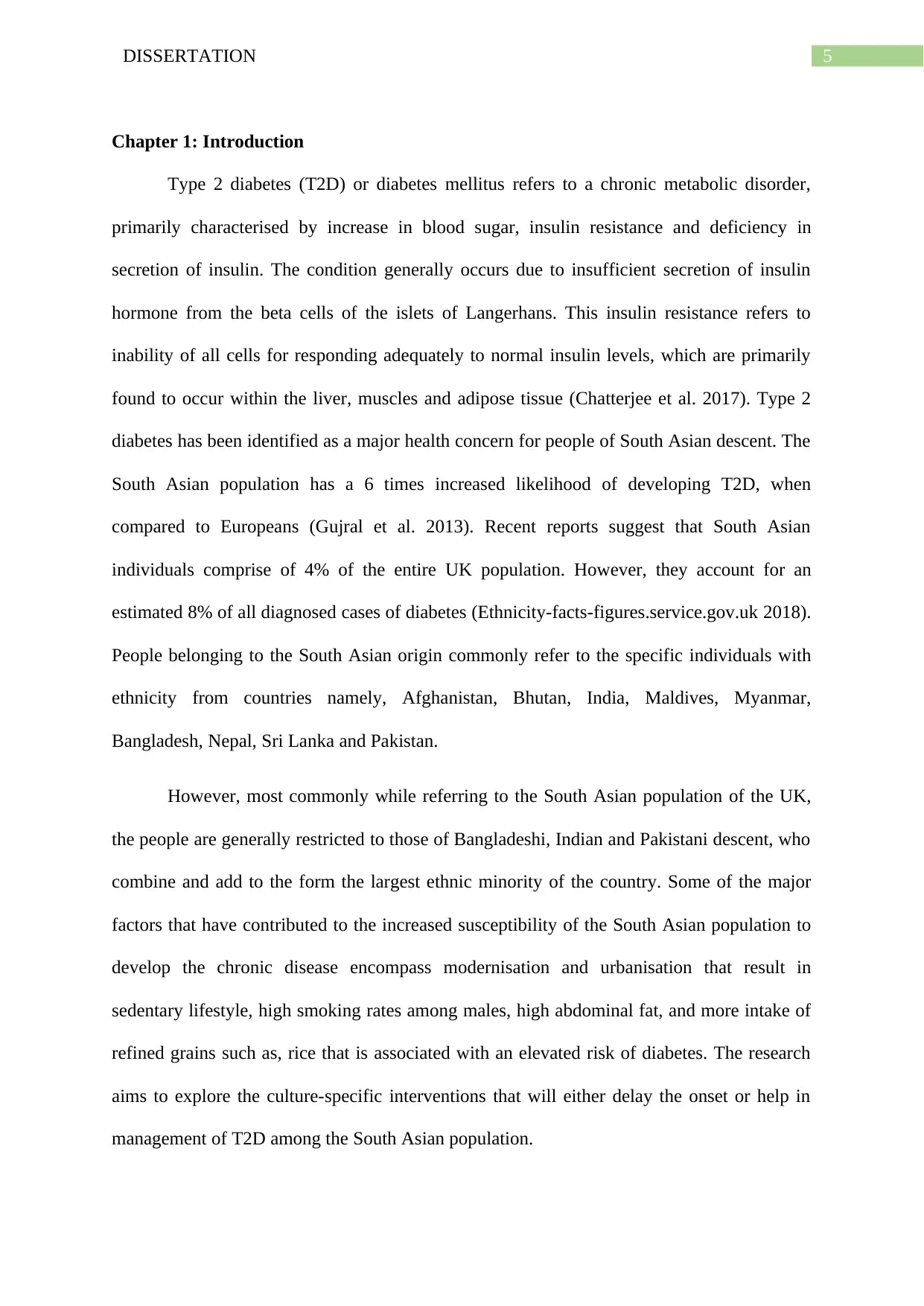
5DISSERTATION
Chapter 1: Introduction
Type 2 diabetes (T2D) or diabetes mellitus refers to a chronic metabolic disorder,
primarily characterised by increase in blood sugar, insulin resistance and deficiency in
secretion of insulin. The condition generally occurs due to insufficient secretion of insulin
hormone from the beta cells of the islets of Langerhans. This insulin resistance refers to
inability of all cells for responding adequately to normal insulin levels, which are primarily
found to occur within the liver, muscles and adipose tissue (Chatterjee et al. 2017). Type 2
diabetes has been identified as a major health concern for people of South Asian descent. The
South Asian population has a 6 times increased likelihood of developing T2D, when
compared to Europeans (Gujral et al. 2013). Recent reports suggest that South Asian
individuals comprise of 4% of the entire UK population. However, they account for an
estimated 8% of all diagnosed cases of diabetes (Ethnicity-facts-figures.service.gov.uk 2018).
People belonging to the South Asian origin commonly refer to the specific individuals with
ethnicity from countries namely, Afghanistan, Bhutan, India, Maldives, Myanmar,
Bangladesh, Nepal, Sri Lanka and Pakistan.
However, most commonly while referring to the South Asian population of the UK,
the people are generally restricted to those of Bangladeshi, Indian and Pakistani descent, who
combine and add to the form the largest ethnic minority of the country. Some of the major
factors that have contributed to the increased susceptibility of the South Asian population to
develop the chronic disease encompass modernisation and urbanisation that result in
sedentary lifestyle, high smoking rates among males, high abdominal fat, and more intake of
refined grains such as, rice that is associated with an elevated risk of diabetes. The research
aims to explore the culture-specific interventions that will either delay the onset or help in
management of T2D among the South Asian population.
Chapter 1: Introduction
Type 2 diabetes (T2D) or diabetes mellitus refers to a chronic metabolic disorder,
primarily characterised by increase in blood sugar, insulin resistance and deficiency in
secretion of insulin. The condition generally occurs due to insufficient secretion of insulin
hormone from the beta cells of the islets of Langerhans. This insulin resistance refers to
inability of all cells for responding adequately to normal insulin levels, which are primarily
found to occur within the liver, muscles and adipose tissue (Chatterjee et al. 2017). Type 2
diabetes has been identified as a major health concern for people of South Asian descent. The
South Asian population has a 6 times increased likelihood of developing T2D, when
compared to Europeans (Gujral et al. 2013). Recent reports suggest that South Asian
individuals comprise of 4% of the entire UK population. However, they account for an
estimated 8% of all diagnosed cases of diabetes (Ethnicity-facts-figures.service.gov.uk 2018).
People belonging to the South Asian origin commonly refer to the specific individuals with
ethnicity from countries namely, Afghanistan, Bhutan, India, Maldives, Myanmar,
Bangladesh, Nepal, Sri Lanka and Pakistan.
However, most commonly while referring to the South Asian population of the UK,
the people are generally restricted to those of Bangladeshi, Indian and Pakistani descent, who
combine and add to the form the largest ethnic minority of the country. Some of the major
factors that have contributed to the increased susceptibility of the South Asian population to
develop the chronic disease encompass modernisation and urbanisation that result in
sedentary lifestyle, high smoking rates among males, high abdominal fat, and more intake of
refined grains such as, rice that is associated with an elevated risk of diabetes. The research
aims to explore the culture-specific interventions that will either delay the onset or help in
management of T2D among the South Asian population.
⊘ This is a preview!⊘
Do you want full access?
Subscribe today to unlock all pages.

Trusted by 1+ million students worldwide
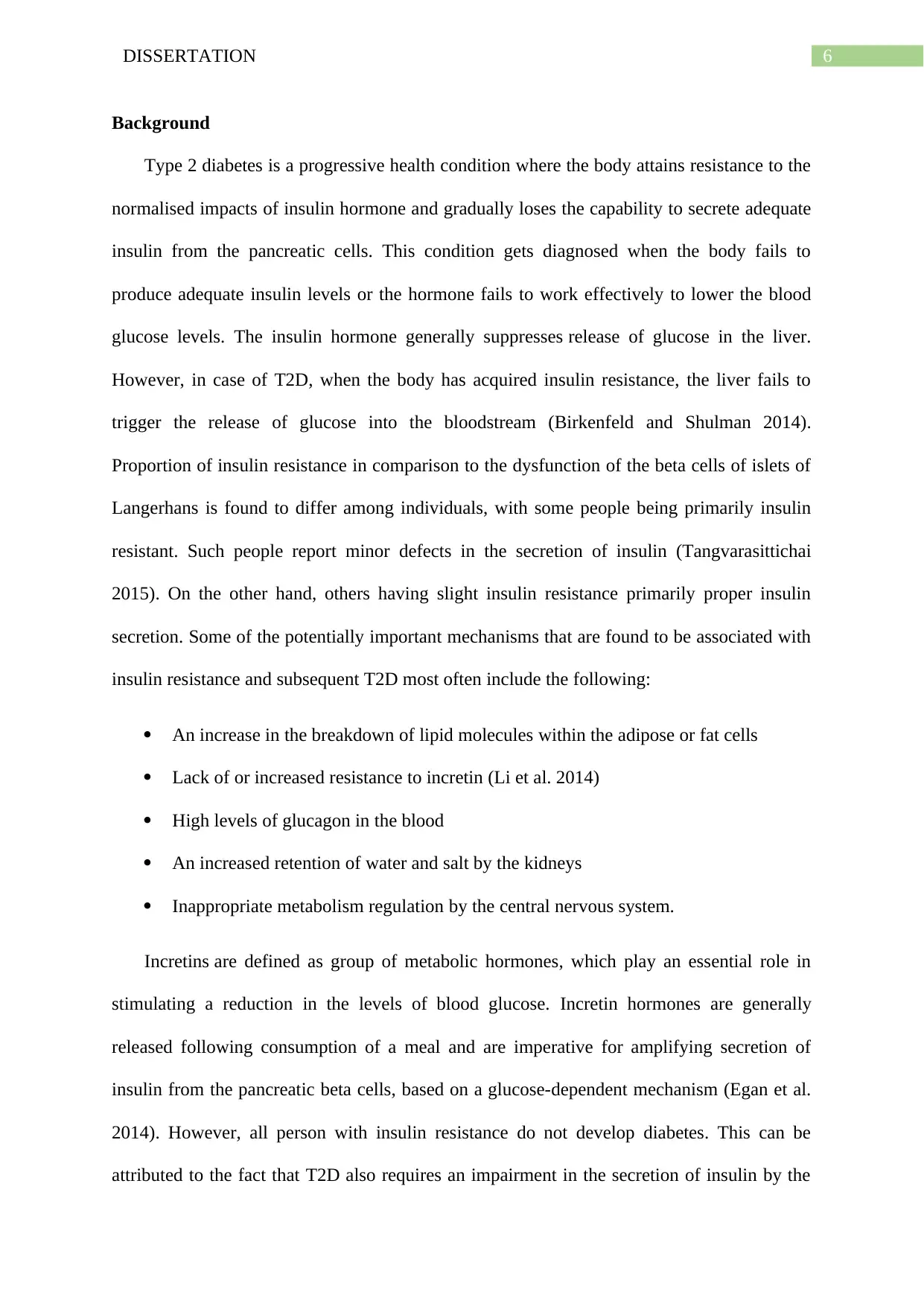
6DISSERTATION
Background
Type 2 diabetes is a progressive health condition where the body attains resistance to the
normalised impacts of insulin hormone and gradually loses the capability to secrete adequate
insulin from the pancreatic cells. This condition gets diagnosed when the body fails to
produce adequate insulin levels or the hormone fails to work effectively to lower the blood
glucose levels. The insulin hormone generally suppresses release of glucose in the liver.
However, in case of T2D, when the body has acquired insulin resistance, the liver fails to
trigger the release of glucose into the bloodstream (Birkenfeld and Shulman 2014).
Proportion of insulin resistance in comparison to the dysfunction of the beta cells of islets of
Langerhans is found to differ among individuals, with some people being primarily insulin
resistant. Such people report minor defects in the secretion of insulin (Tangvarasittichai
2015). On the other hand, others having slight insulin resistance primarily proper insulin
secretion. Some of the potentially important mechanisms that are found to be associated with
insulin resistance and subsequent T2D most often include the following:
An increase in the breakdown of lipid molecules within the adipose or fat cells
Lack of or increased resistance to incretin (Li et al. 2014)
High levels of glucagon in the blood
An increased retention of water and salt by the kidneys
Inappropriate metabolism regulation by the central nervous system.
Incretins are defined as group of metabolic hormones, which play an essential role in
stimulating a reduction in the levels of blood glucose. Incretin hormones are generally
released following consumption of a meal and are imperative for amplifying secretion of
insulin from the pancreatic beta cells, based on a glucose-dependent mechanism (Egan et al.
2014). However, all person with insulin resistance do not develop diabetes. This can be
attributed to the fact that T2D also requires an impairment in the secretion of insulin by the
Background
Type 2 diabetes is a progressive health condition where the body attains resistance to the
normalised impacts of insulin hormone and gradually loses the capability to secrete adequate
insulin from the pancreatic cells. This condition gets diagnosed when the body fails to
produce adequate insulin levels or the hormone fails to work effectively to lower the blood
glucose levels. The insulin hormone generally suppresses release of glucose in the liver.
However, in case of T2D, when the body has acquired insulin resistance, the liver fails to
trigger the release of glucose into the bloodstream (Birkenfeld and Shulman 2014).
Proportion of insulin resistance in comparison to the dysfunction of the beta cells of islets of
Langerhans is found to differ among individuals, with some people being primarily insulin
resistant. Such people report minor defects in the secretion of insulin (Tangvarasittichai
2015). On the other hand, others having slight insulin resistance primarily proper insulin
secretion. Some of the potentially important mechanisms that are found to be associated with
insulin resistance and subsequent T2D most often include the following:
An increase in the breakdown of lipid molecules within the adipose or fat cells
Lack of or increased resistance to incretin (Li et al. 2014)
High levels of glucagon in the blood
An increased retention of water and salt by the kidneys
Inappropriate metabolism regulation by the central nervous system.
Incretins are defined as group of metabolic hormones, which play an essential role in
stimulating a reduction in the levels of blood glucose. Incretin hormones are generally
released following consumption of a meal and are imperative for amplifying secretion of
insulin from the pancreatic beta cells, based on a glucose-dependent mechanism (Egan et al.
2014). However, all person with insulin resistance do not develop diabetes. This can be
attributed to the fact that T2D also requires an impairment in the secretion of insulin by the
Paraphrase This Document
Need a fresh take? Get an instant paraphrase of this document with our AI Paraphraser
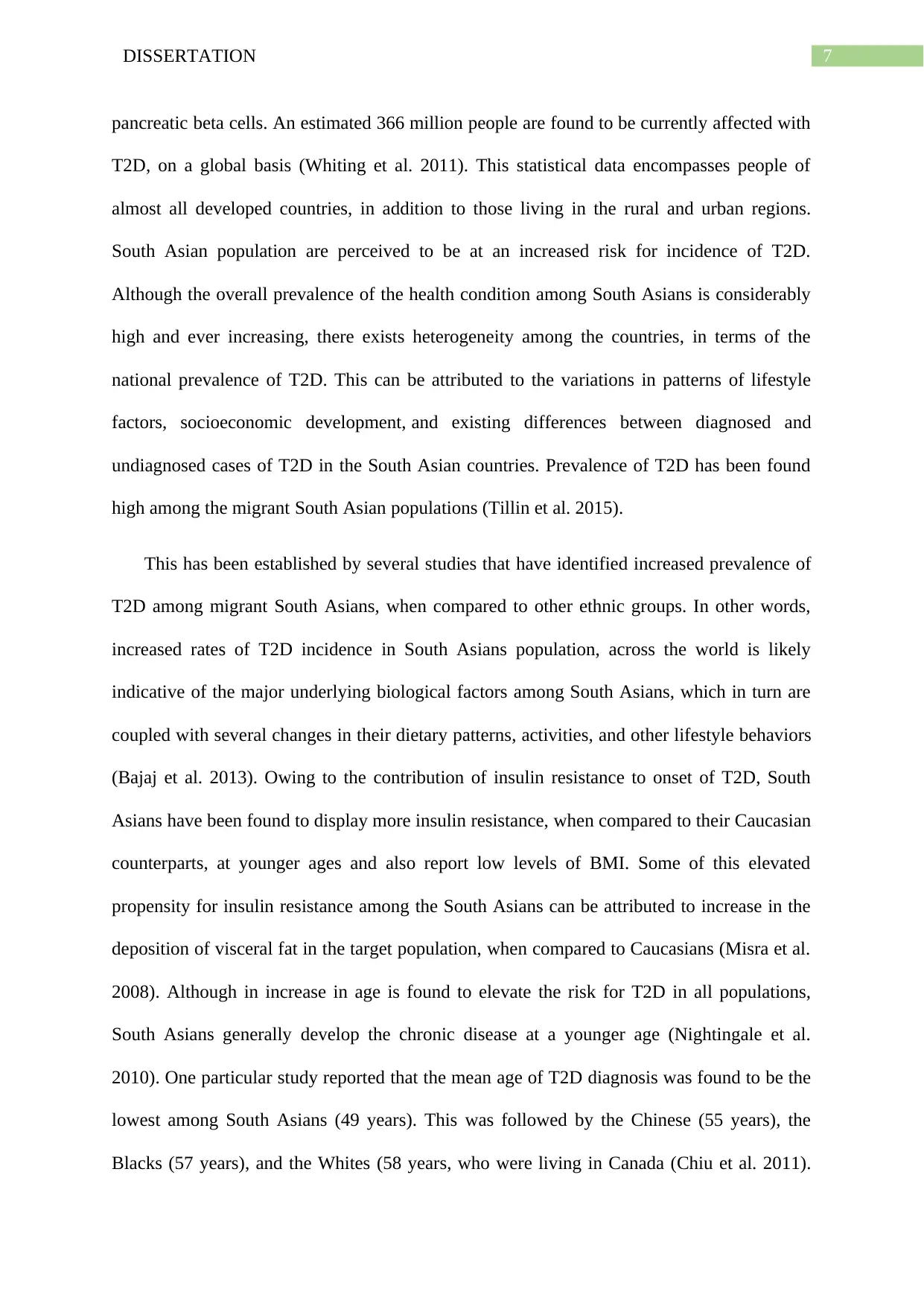
7DISSERTATION
pancreatic beta cells. An estimated 366 million people are found to be currently affected with
T2D, on a global basis (Whiting et al. 2011). This statistical data encompasses people of
almost all developed countries, in addition to those living in the rural and urban regions.
South Asian population are perceived to be at an increased risk for incidence of T2D.
Although the overall prevalence of the health condition among South Asians is considerably
high and ever increasing, there exists heterogeneity among the countries, in terms of the
national prevalence of T2D. This can be attributed to the variations in patterns of lifestyle
factors, socioeconomic development, and existing differences between diagnosed and
undiagnosed cases of T2D in the South Asian countries. Prevalence of T2D has been found
high among the migrant South Asian populations (Tillin et al. 2015).
This has been established by several studies that have identified increased prevalence of
T2D among migrant South Asians, when compared to other ethnic groups. In other words,
increased rates of T2D incidence in South Asians population, across the world is likely
indicative of the major underlying biological factors among South Asians, which in turn are
coupled with several changes in their dietary patterns, activities, and other lifestyle behaviors
(Bajaj et al. 2013). Owing to the contribution of insulin resistance to onset of T2D, South
Asians have been found to display more insulin resistance, when compared to their Caucasian
counterparts, at younger ages and also report low levels of BMI. Some of this elevated
propensity for insulin resistance among the South Asians can be attributed to increase in the
deposition of visceral fat in the target population, when compared to Caucasians (Misra et al.
2008). Although in increase in age is found to elevate the risk for T2D in all populations,
South Asians generally develop the chronic disease at a younger age (Nightingale et al.
2010). One particular study reported that the mean age of T2D diagnosis was found to be the
lowest among South Asians (49 years). This was followed by the Chinese (55 years), the
Blacks (57 years), and the Whites (58 years, who were living in Canada (Chiu et al. 2011).
pancreatic beta cells. An estimated 366 million people are found to be currently affected with
T2D, on a global basis (Whiting et al. 2011). This statistical data encompasses people of
almost all developed countries, in addition to those living in the rural and urban regions.
South Asian population are perceived to be at an increased risk for incidence of T2D.
Although the overall prevalence of the health condition among South Asians is considerably
high and ever increasing, there exists heterogeneity among the countries, in terms of the
national prevalence of T2D. This can be attributed to the variations in patterns of lifestyle
factors, socioeconomic development, and existing differences between diagnosed and
undiagnosed cases of T2D in the South Asian countries. Prevalence of T2D has been found
high among the migrant South Asian populations (Tillin et al. 2015).
This has been established by several studies that have identified increased prevalence of
T2D among migrant South Asians, when compared to other ethnic groups. In other words,
increased rates of T2D incidence in South Asians population, across the world is likely
indicative of the major underlying biological factors among South Asians, which in turn are
coupled with several changes in their dietary patterns, activities, and other lifestyle behaviors
(Bajaj et al. 2013). Owing to the contribution of insulin resistance to onset of T2D, South
Asians have been found to display more insulin resistance, when compared to their Caucasian
counterparts, at younger ages and also report low levels of BMI. Some of this elevated
propensity for insulin resistance among the South Asians can be attributed to increase in the
deposition of visceral fat in the target population, when compared to Caucasians (Misra et al.
2008). Although in increase in age is found to elevate the risk for T2D in all populations,
South Asians generally develop the chronic disease at a younger age (Nightingale et al.
2010). One particular study reported that the mean age of T2D diagnosis was found to be the
lowest among South Asians (49 years). This was followed by the Chinese (55 years), the
Blacks (57 years), and the Whites (58 years, who were living in Canada (Chiu et al. 2011).
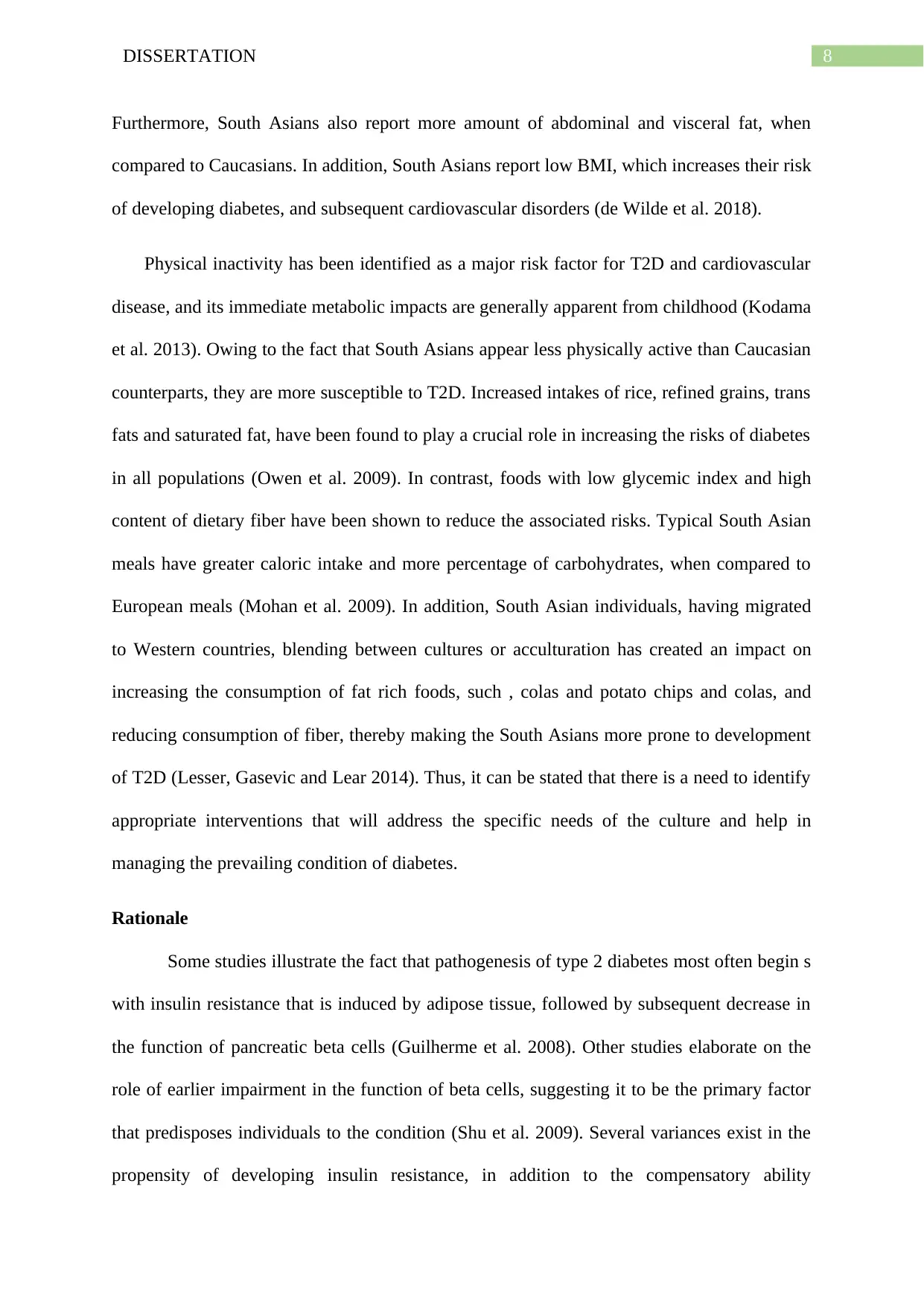
8DISSERTATION
Furthermore, South Asians also report more amount of abdominal and visceral fat, when
compared to Caucasians. In addition, South Asians report low BMI, which increases their risk
of developing diabetes, and subsequent cardiovascular disorders (de Wilde et al. 2018).
Physical inactivity has been identified as a major risk factor for T2D and cardiovascular
disease, and its immediate metabolic impacts are generally apparent from childhood (Kodama
et al. 2013). Owing to the fact that South Asians appear less physically active than Caucasian
counterparts, they are more susceptible to T2D. Increased intakes of rice, refined grains, trans
fats and saturated fat, have been found to play a crucial role in increasing the risks of diabetes
in all populations (Owen et al. 2009). In contrast, foods with low glycemic index and high
content of dietary fiber have been shown to reduce the associated risks. Typical South Asian
meals have greater caloric intake and more percentage of carbohydrates, when compared to
European meals (Mohan et al. 2009). In addition, South Asian individuals, having migrated
to Western countries, blending between cultures or acculturation has created an impact on
increasing the consumption of fat rich foods, such , colas and potato chips and colas, and
reducing consumption of fiber, thereby making the South Asians more prone to development
of T2D (Lesser, Gasevic and Lear 2014). Thus, it can be stated that there is a need to identify
appropriate interventions that will address the specific needs of the culture and help in
managing the prevailing condition of diabetes.
Rationale
Some studies illustrate the fact that pathogenesis of type 2 diabetes most often begin s
with insulin resistance that is induced by adipose tissue, followed by subsequent decrease in
the function of pancreatic beta cells (Guilherme et al. 2008). Other studies elaborate on the
role of earlier impairment in the function of beta cells, suggesting it to be the primary factor
that predisposes individuals to the condition (Shu et al. 2009). Several variances exist in the
propensity of developing insulin resistance, in addition to the compensatory ability
Furthermore, South Asians also report more amount of abdominal and visceral fat, when
compared to Caucasians. In addition, South Asians report low BMI, which increases their risk
of developing diabetes, and subsequent cardiovascular disorders (de Wilde et al. 2018).
Physical inactivity has been identified as a major risk factor for T2D and cardiovascular
disease, and its immediate metabolic impacts are generally apparent from childhood (Kodama
et al. 2013). Owing to the fact that South Asians appear less physically active than Caucasian
counterparts, they are more susceptible to T2D. Increased intakes of rice, refined grains, trans
fats and saturated fat, have been found to play a crucial role in increasing the risks of diabetes
in all populations (Owen et al. 2009). In contrast, foods with low glycemic index and high
content of dietary fiber have been shown to reduce the associated risks. Typical South Asian
meals have greater caloric intake and more percentage of carbohydrates, when compared to
European meals (Mohan et al. 2009). In addition, South Asian individuals, having migrated
to Western countries, blending between cultures or acculturation has created an impact on
increasing the consumption of fat rich foods, such , colas and potato chips and colas, and
reducing consumption of fiber, thereby making the South Asians more prone to development
of T2D (Lesser, Gasevic and Lear 2014). Thus, it can be stated that there is a need to identify
appropriate interventions that will address the specific needs of the culture and help in
managing the prevailing condition of diabetes.
Rationale
Some studies illustrate the fact that pathogenesis of type 2 diabetes most often begin s
with insulin resistance that is induced by adipose tissue, followed by subsequent decrease in
the function of pancreatic beta cells (Guilherme et al. 2008). Other studies elaborate on the
role of earlier impairment in the function of beta cells, suggesting it to be the primary factor
that predisposes individuals to the condition (Shu et al. 2009). Several variances exist in the
propensity of developing insulin resistance, in addition to the compensatory ability
⊘ This is a preview!⊘
Do you want full access?
Subscribe today to unlock all pages.

Trusted by 1+ million students worldwide

9DISSERTATION
demonstrated by beta cells that explain the existing ethnic differences in susceptibility to
T2D. Strong evidences suggest the presence of more insulin resistance among the South
Asians, at a younger age, with comparative BMI levels (Bhardwaj et al. 2008). This increase
in propensity among the South Asians for developing insulin resistance is attributable to their
higher body fat. Data obtained from a Chennai Urban Rural Epidemiology Study (CURES)
established the fact that visceral fat associated progressive increase have contributed
primarily to an elevated glucose intolerance in South Asians (Indulekha et al. 2011). In
addition, South Asians have also demonstrated significant reductions in their glucose disposal
rates, while demonstrating increased amount of abdominal and visceral fat. Greater amounts
of visceral fat in non-diabetic South Asians have also been associated with increased insulin
resistance.
However, gender differences might play a role in the distribution of body fat among
South Asians and their subsequent insulin resistance (Ramachandran, Ma and Snehalatha
2010). In addition, large number of genome-wide association studies have also been
conducted that have successfully identified the link between incidence of T2D and an
estimated 60 genes (Kooner et al. 2011). However, most of these studies gave been
conducted in the context of European population, and only few of them have taken attempts
for replicating findings of these studies among South Asians (Cho et al. 2012). Recent
replication studies conducted in the South Asian population have also determined the fact that
common T2D variants, which were previously thought to be prevalent in the European
populations, such as TCF7L2, FTO, PPARG, and CDKN2A, have also been associated with
T2D in South Asians (Rees et al. 2011). However, the FTO gene, has been found associated
with T2D in both South Asian and European population (Yajnik et al. 2009).
The rationale for this research is also associated with the fact that global incidence of
type 2 diabetes has been found to create significant ramifications on the South Asian
demonstrated by beta cells that explain the existing ethnic differences in susceptibility to
T2D. Strong evidences suggest the presence of more insulin resistance among the South
Asians, at a younger age, with comparative BMI levels (Bhardwaj et al. 2008). This increase
in propensity among the South Asians for developing insulin resistance is attributable to their
higher body fat. Data obtained from a Chennai Urban Rural Epidemiology Study (CURES)
established the fact that visceral fat associated progressive increase have contributed
primarily to an elevated glucose intolerance in South Asians (Indulekha et al. 2011). In
addition, South Asians have also demonstrated significant reductions in their glucose disposal
rates, while demonstrating increased amount of abdominal and visceral fat. Greater amounts
of visceral fat in non-diabetic South Asians have also been associated with increased insulin
resistance.
However, gender differences might play a role in the distribution of body fat among
South Asians and their subsequent insulin resistance (Ramachandran, Ma and Snehalatha
2010). In addition, large number of genome-wide association studies have also been
conducted that have successfully identified the link between incidence of T2D and an
estimated 60 genes (Kooner et al. 2011). However, most of these studies gave been
conducted in the context of European population, and only few of them have taken attempts
for replicating findings of these studies among South Asians (Cho et al. 2012). Recent
replication studies conducted in the South Asian population have also determined the fact that
common T2D variants, which were previously thought to be prevalent in the European
populations, such as TCF7L2, FTO, PPARG, and CDKN2A, have also been associated with
T2D in South Asians (Rees et al. 2011). However, the FTO gene, has been found associated
with T2D in both South Asian and European population (Yajnik et al. 2009).
The rationale for this research is also associated with the fact that global incidence of
type 2 diabetes has been found to create significant ramifications on the South Asian
Paraphrase This Document
Need a fresh take? Get an instant paraphrase of this document with our AI Paraphraser

10DISSERTATION
population as it increases the risks of stroke and myocardial infarction by two or four times,
when compared to those without diabetes (Wasay, Khatri and Kaul 2014). There exist several
biomarkers such as, adiponectin, C-reactive protein and leptin that act as markers of oxidative
stress and might play a crucial role in the greater prevalence of T2D among South Asians,
when compared to different ethnic groups (Gujral et al. 2013). Oxidative stress commonly
occurs due to an increase in the amount of reactive oxygen species (ROS) and have been
identified to play an important role in the development of T2D. There exists a lack of study
that assessed the levels of these biomarkers in the South Asian population. Furthermore,
oxidative stress has also been linked to increased levels of visceral fat that increases the risks
for South Asians, compared to other groups (Chambers et al. 2015). In line with the high
prevalence of T2D, a worldwide epidemic of obesity and overweight is on the rise.
Nutritional transition after migration plays an essential role in the high prevalence of T2D
among the South Asians living in the UK. Immigrants from the middle and low income
countries of South Asia comprise of a larger proportion of the European population. Over
time, there occurred a mutual exchange of habits and ideas between the immigrants and the
UK population that served as the host (Garduño‐Diaz and Khokhar 2013).
With regards to their food habits, the immigrants were found to be largely influenced
by the food culture practiced by the majority, which lead them to change their dietary habits,
while they contributed to the spectre of newer food items in restaurants and shops. Few
studies have compared the waist circumference and the Body Mass Index (BMI) between the
South Asians settled in Europe and their counterparts with same genetic and cultural
backgrounds, in their country of origin such as Sri Lanka and Pakistan (Zahid et al. 2011;
Tennakoon et al. 2010). These studies have consistently found that European Asians have
higher BMI (point difference of 2.1–5.8), when compared to their counterparts. Furthermore,
a meta-analysis conducted across 199 countries provided evidence for an increase in the
population as it increases the risks of stroke and myocardial infarction by two or four times,
when compared to those without diabetes (Wasay, Khatri and Kaul 2014). There exist several
biomarkers such as, adiponectin, C-reactive protein and leptin that act as markers of oxidative
stress and might play a crucial role in the greater prevalence of T2D among South Asians,
when compared to different ethnic groups (Gujral et al. 2013). Oxidative stress commonly
occurs due to an increase in the amount of reactive oxygen species (ROS) and have been
identified to play an important role in the development of T2D. There exists a lack of study
that assessed the levels of these biomarkers in the South Asian population. Furthermore,
oxidative stress has also been linked to increased levels of visceral fat that increases the risks
for South Asians, compared to other groups (Chambers et al. 2015). In line with the high
prevalence of T2D, a worldwide epidemic of obesity and overweight is on the rise.
Nutritional transition after migration plays an essential role in the high prevalence of T2D
among the South Asians living in the UK. Immigrants from the middle and low income
countries of South Asia comprise of a larger proportion of the European population. Over
time, there occurred a mutual exchange of habits and ideas between the immigrants and the
UK population that served as the host (Garduño‐Diaz and Khokhar 2013).
With regards to their food habits, the immigrants were found to be largely influenced
by the food culture practiced by the majority, which lead them to change their dietary habits,
while they contributed to the spectre of newer food items in restaurants and shops. Few
studies have compared the waist circumference and the Body Mass Index (BMI) between the
South Asians settled in Europe and their counterparts with same genetic and cultural
backgrounds, in their country of origin such as Sri Lanka and Pakistan (Zahid et al. 2011;
Tennakoon et al. 2010). These studies have consistently found that European Asians have
higher BMI (point difference of 2.1–5.8), when compared to their counterparts. Furthermore,
a meta-analysis conducted across 199 countries provided evidence for an increase in the
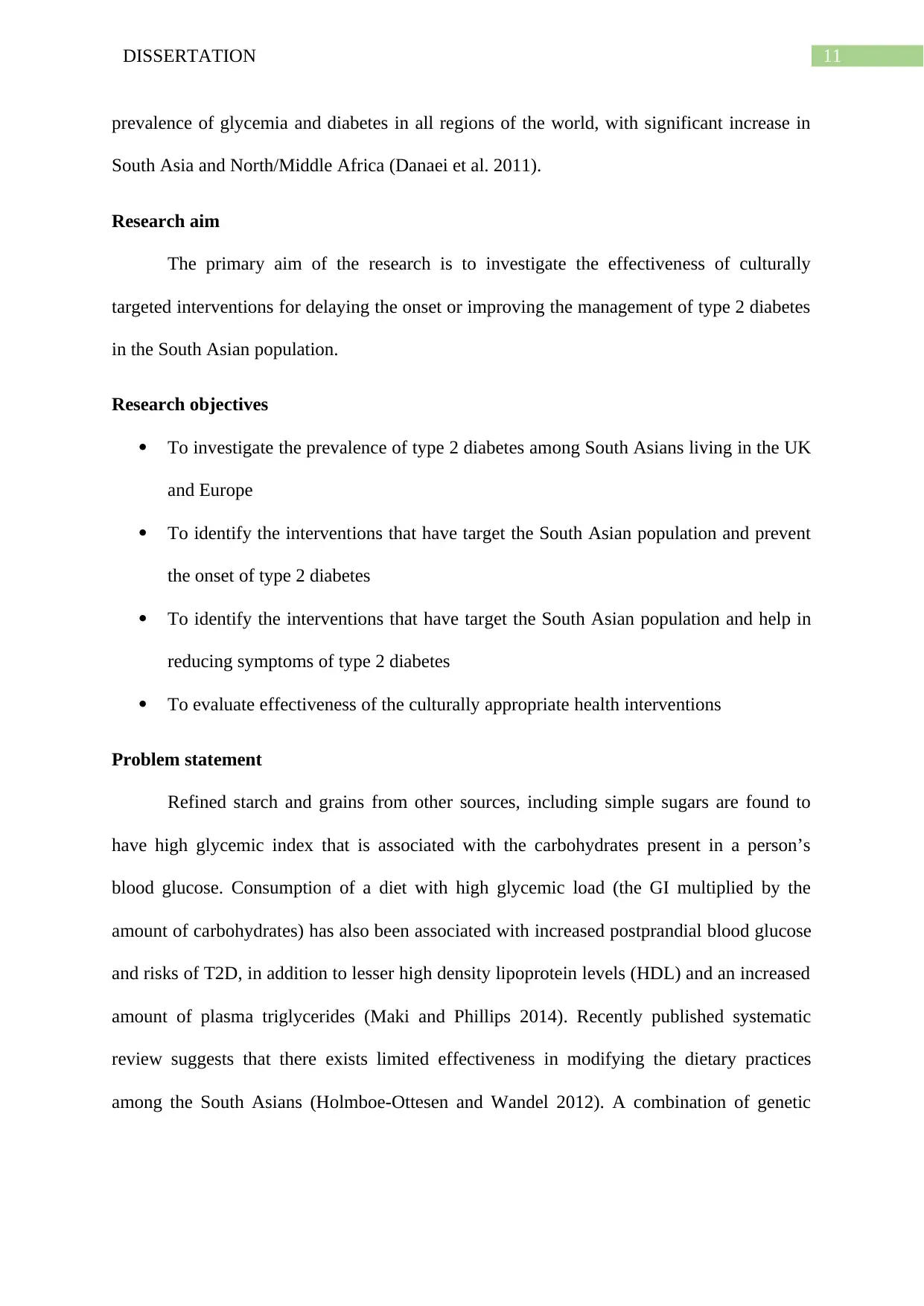
11DISSERTATION
prevalence of glycemia and diabetes in all regions of the world, with significant increase in
South Asia and North/Middle Africa (Danaei et al. 2011).
Research aim
The primary aim of the research is to investigate the effectiveness of culturally
targeted interventions for delaying the onset or improving the management of type 2 diabetes
in the South Asian population.
Research objectives
To investigate the prevalence of type 2 diabetes among South Asians living in the UK
and Europe
To identify the interventions that have target the South Asian population and prevent
the onset of type 2 diabetes
To identify the interventions that have target the South Asian population and help in
reducing symptoms of type 2 diabetes
To evaluate effectiveness of the culturally appropriate health interventions
Problem statement
Refined starch and grains from other sources, including simple sugars are found to
have high glycemic index that is associated with the carbohydrates present in a person’s
blood glucose. Consumption of a diet with high glycemic load (the GI multiplied by the
amount of carbohydrates) has also been associated with increased postprandial blood glucose
and risks of T2D, in addition to lesser high density lipoprotein levels (HDL) and an increased
amount of plasma triglycerides (Maki and Phillips 2014). Recently published systematic
review suggests that there exists limited effectiveness in modifying the dietary practices
among the South Asians (Holmboe-Ottesen and Wandel 2012). A combination of genetic
prevalence of glycemia and diabetes in all regions of the world, with significant increase in
South Asia and North/Middle Africa (Danaei et al. 2011).
Research aim
The primary aim of the research is to investigate the effectiveness of culturally
targeted interventions for delaying the onset or improving the management of type 2 diabetes
in the South Asian population.
Research objectives
To investigate the prevalence of type 2 diabetes among South Asians living in the UK
and Europe
To identify the interventions that have target the South Asian population and prevent
the onset of type 2 diabetes
To identify the interventions that have target the South Asian population and help in
reducing symptoms of type 2 diabetes
To evaluate effectiveness of the culturally appropriate health interventions
Problem statement
Refined starch and grains from other sources, including simple sugars are found to
have high glycemic index that is associated with the carbohydrates present in a person’s
blood glucose. Consumption of a diet with high glycemic load (the GI multiplied by the
amount of carbohydrates) has also been associated with increased postprandial blood glucose
and risks of T2D, in addition to lesser high density lipoprotein levels (HDL) and an increased
amount of plasma triglycerides (Maki and Phillips 2014). Recently published systematic
review suggests that there exists limited effectiveness in modifying the dietary practices
among the South Asians (Holmboe-Ottesen and Wandel 2012). A combination of genetic
⊘ This is a preview!⊘
Do you want full access?
Subscribe today to unlock all pages.

Trusted by 1+ million students worldwide
1 out of 78
Related Documents
Your All-in-One AI-Powered Toolkit for Academic Success.
+13062052269
info@desklib.com
Available 24*7 on WhatsApp / Email
![[object Object]](/_next/static/media/star-bottom.7253800d.svg)
Unlock your academic potential
Copyright © 2020–2025 A2Z Services. All Rights Reserved. Developed and managed by ZUCOL.




